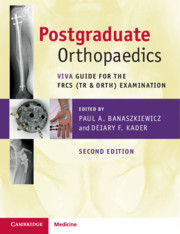Description
Postgraduate Orthopaedics (2nd Ed., Revised edition)
Viva Guide for the FRCS (Tr & Orth) Examination
Coordinators: Banaszkiewicz Paul A., Kader Deiary F.
Successfully navigate key topics required to master the FRCS (Tr & Orth) exam with confidence, using this thoroughly revised second edition.
Language: English
Subject for Postgraduate Orthopaedics:
Publication date: 12-2019
790 p. · 18.9x24.6 cm · Paperback
790 p. · 18.9x24.6 cm · Paperback
Description
/li>Contents
/li>Biography
/li>
Develop an aptitude for defining key topics, features and processes, vital for your FRCS (Tr&Orth) Viva exam success, with this newly updated and detailed guide. This new edition expertly delivers invaluable insights into tactics and planning, for candidates to sharpen exam skills, and gain confidence. Thoroughly updated to include an expanded basic science section, to answer all of your viva questions, this guide also supplies candidates with new illustrations and exam-specific diagrams; adapting to meet the expectations of a constantly changing syllabus. Vital for orthopaedic surgeons in training, this forward-looking text includes a drawing chapter, for candidates to practise creating succinct, exam-style illustrations, before the exam itself. Proactive in its approach, this book addresses the balance between trauma, general orthopaedics and basic science; by editors with extensive national and international experience of preparing candidates for the FRCS(Tr & Orth).
Foreword; Preface; List of abbreviations; Part I. The FRCS (Tr & Orth) Oral Examination: 1. General oral guidance Tom Symes and Paul A. Banaszkiewicz; Part II. Adult Elective Orthopaedics and Spine: 2. Hip structured oral questions Paul A. Banaszkiewicz and Rahul Kakkar; 3. Knee structured oral questions Michael Maru and Deiary F. Kader; 4. Foot and ankle structured oral questions N. Jane Madeley and Neil Forrest; 5. Spine structured oral questions Alex Baker; 6. Shoulder and elbow structured oral questions Asir Aster; 7. Orthopaedic oncology Thomas B. Beckingsale; Part III. Trauma: 8. Lower limb Mohammed Al-Maiyah; 9. Upper limb Gunasekaran Kumar; 10. Pelvic and spinal trauma Gunasekaran Kumar and Sherief Elsayed; Part IV. Children's Orthopaedics/Hand and Upper Limb: 11. Hand and upper limb John Harrison and Santosh Venkatachalam; 12. Children's orthopaedics Sattar Alshryda and Akinwande Adedapo; Part V. Applied Basic Sciences: 13. Anatomy and surgical approaches Tom Symes; 14. Pathology Sunit Patil; 15. Biomaterials and biomechanics Iain McNamara and Andrew P. Sprowson; 16. Tissues of the musculoskeletal system Andrew P. Sprowson and Iain McNamara; 17. Evidence based practice Sattar Alshryda and James Mason; 18. Imaging and investigative techniques Rajesh Kakwani and Mike Newby; Part VI. Diagrams for the FRCS (Tr & Orth): 19. Diagrams for the FRCS (Tr & Orth) Asir Aster and Muthu Jeyam; Index.
Paul A. Banaszkiewicz is Consultant Orthopaedic Surgeon, Queen Elizabeth Hospital and North East Surgery Centre, Gateshead. Visiting Professor, Northumbria University, Newcastle upon Tyne.
Deiary F. Kader is a knee arthroplasty and arthroscopy surgeon, humanitarian, academic, educationalist and a researcher at the academic unit, South West London Elective Orthopaedic Centre (SWLEOC). He is also a specialist war trauma reconstruction surgeon for the International Committee of the Red Cross (ICRC) in the Middle East.
Deiary F. Kader is a knee arthroplasty and arthroscopy surgeon, humanitarian, academic, educationalist and a researcher at the academic unit, South West London Elective Orthopaedic Centre (SWLEOC). He is also a specialist war trauma reconstruction surgeon for the International Committee of the Red Cross (ICRC) in the Middle East.
© 2024 LAVOISIER S.A.S.




